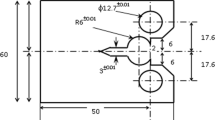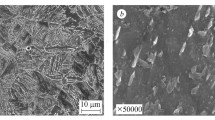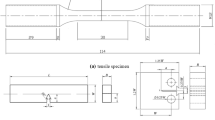The fracture toughness of high-strength ferritic steels within the temperature range of ductile-tocleavage transition is analyzed. We tested two steels: S960QC and Hardox-400. The experimental results are compared with the results obtained by using the standard Master Curve (MC) equation. It turns out that the MC equation can be adopted to predict the fracture toughness of the high-strength steels after certain modifications. The shape of the formula can be preserved but some coefficients should be changed. The relationship between the fracture toughness and the thickness of an element included in the MC formula does not exist in the case of high-strength steels. One formula cannot be proposed for the MC of the tested steels, in contrast to the steels with a yield stress below 825 MPa.









Similar content being viewed by others
References
K. Wallin, “The scatter in K Ic results,” Eng. Fract. Mech., 19, No. 6, 1085–1093 (1984).
X. Gao and R. H. Dodds, “Constraint effects on the ductile-to-cleavage transition temperature of ferritic steels: a Weibull stress model,” Int. J. Fract., 102, 43–69 (2000).
J. A. Joyce and R. L. Tregoning, “Investigation of specimen geometry effects and material inhomogeneity effects in A533B steel,” in: Proc. ECF 14, Fracture Mechanics Beyond 2000, Vol. II/III, Krakow (2002), pp. 55–63.
C. Ruggeri, R. H. Dodds, and K. Wallin, “Constraint effects on reference temperature, T 0, for ferritic steels in the transition region,” Eng. Fract. Mech., 60, No. 1, 19–36 (1998).
I. R. Dzioba, O. Z. Student, and A. D. Markov, “On the contemporary SINTAP approach and its application to the evaluation on the serviceability of welded joints of steam pipelines of thermal power plants,” Fiz.-Khim. Mekh. Mater., 41, No. 6, 70–79 (2005), English translation: Mater. Sci., 41, No. 6, 791–804 (2005).
I. R. Dzioba and O. T. Tsyrul'nyk, “Analysis of the integrity of welded pipe of gas mains by the FITNET procedures,” Fiz.-Khim. Mekh. Mater., 45, No. 6, 57–64 (2005), English translation: Mater. Sci., 45, No. 6, 817–825.
“ASTM E1921-05. Standard test method for determination of reference temperature, T 0, for ferritic steels in the transition range,” in: Annual Book of ASTM Standards, Vol. 03.01 (2005), pp. 1128–1147.
M. Koçak, S. Webster, J. J. Janosh, R. A. Ainsworth, and R. Koers (editors), FITNET. Fitness for Service Procedure, GKSS Research Centre Geesthacht GmbH, Stuttgart (2008).
K. Wallin and P. Nevasmaa, Structural Integrity Assessment Procedures for European Industry (SINTAP), Sub-Task 3.2 Report: Methodology for the Treatment of Fracture Toughness Data: Procedure and Validation, Report No. VAL A: SINTAP/VTT/7.VTT Manufacturing Technology, Espoo (1998).
A. C. Bannister, Structural Integrity Assessment Procedures for European Industry (SINTAP), Sub-Task 3.3 Report: Determination of Fracture Toughness from Charpy Impact Energy: Procedure and Validation, Report No. SINTAP/BS/15. British Steel plc. (1997).
P. Nevasmaa, P. Karjalainen-Roikonen, A. Laukkanen, T. Nykänen, A. Ameri, T. Björk, T. Limnell, and J. Kuoppala, Fracture Characteristics of New Ultra High-Strength Steel with Yield Strengths 900–960 MPa, Rautaruukki Corporation (2010).
D. Porter, Developments in Hot-Rolled High-Strength Structural Steels, Nordic Welding Conference 06: New Trends in Welding Technology, Tampere, Finland (2006).
A. Neimitz, I. Dzioba, and T. Limnell, “Modified master curve of ultra high-strength steel,” Int. J. Pressure Vessels Piping, 92, 19–26 (2012).
A. Neimitz, I. Dzioba, and T. Pala, “Master curve of high-strength ferritic steel S960QC,” Key Eng. Mat., 598, 178–183 (2014).
Bainite in Steels, Bhadeshia H.K.D.H., Institute of Materials, London (2001)
I. R. Dzioba, “Properties of 13HMF steel after operation and degradation under the laboratory conditions,” Fiz.-Khim. Mekh. Mater., 46, No. 3, 65–72 (2010), English translation : Mater. Sci., 46, No. 3, 357–364 (2010).
ASTM E1737-96. Standard Test Method for J -Integral Characterization of Fracture Toughness, ASTM International, West Conshohochen, PA (1996).
ASTM E1820-09. Standard Test Method for Measurement of Fracture Toughness, Annual Book of ASTM Standards, Vol. 03.01 (2011), pp. 1070–1118.
I. Dzioba, R. Pała, and T. Pała, “Temperature dependence of fracture of high-strength ferritic steel Hardox-400,” Acta Mech. Automat., 7, No. 4, 222–225 (2013).
Acknowledgements
Financial support from the Polish Ministry of Science and Higher Education under Contract No. 2014/15/B/ST8/00205 is gratefully acknowledged.
Author information
Authors and Affiliations
Corresponding author
Additional information
Published in Fizyko-Khimichna Mekhanika Materialiv, Vol. 53, No. 2, pp. 16–23, March–April, 2017.
Rights and permissions
About this article
Cite this article
Neimitz, A., Dzioba, І.R. Fracture Toughness of High-Strength Steels Within the Temperature Range of Ductile-to-Cleavage Transition. Master Curves. Mater Sci 53, 141–150 (2017). https://doi.org/10.1007/s11003-017-0055-1
Received:
Published:
Issue Date:
DOI: https://doi.org/10.1007/s11003-017-0055-1




